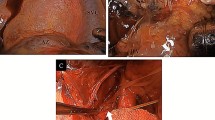Abstract
Acute injuries of the tracheobronchial system are rare and life-threatening situations. Tracheal rupture most commonly occurs after blunt trauma to the chest. It is a rare but most concerning immediate complication of intubation. One-lung ventilation is required in lung surgery. Video assisted thoracoscopic procedures are an absolute indication for one-lung intubation. The double-lumen tube is the mainstay of one lung ventilation. Due to their larger size and rigidity, double lumen tubes are more difficult to insert, and complications are more common than with single lumen tubes. Opinions about the need for checking routinely the position of a double lumen tube by fiber optic bronchoscopy directly after intubation are divided. A 69-year-old woman with epidermoid lung carcinoma was scheduled for video assisted thoracoscopic left upper pulmonary lobectomy under general anaesthesia. The patient was prepared for the operation and itubated with the Carlens double lumen tube as usual. On introducing the camera into the thoracic cavity, the surgeon noted that the lungs were not completely collapsed. During blind adjustment the position of the tube the trachea was ruptured. The right-sided thoracotomy was performed and closed the greater part of the tracheal laceration. Only its upper 1.5-cm segment was surgically inaccessible because of the anatomical situation and thus remained unsutured. The patient received antibiotics, continuous airway humidification, analgesia with piritramide, and chest physiotherapy. She had no complications. In the literature, opinions about checking routinely the position of a double lumen tube by fiber optic bronchoscopy are divided.. Possibly, the very serious complication encountered in our patient could have been avoided, had the tube position been checked by bronchoscopy. The treatment strategy for post-intubation tracheal rupture depends on the size and location of the rupture, its clinical presentation, and the overall condition of the patient). Early surgical repair is the treatment of choice for most patients when a transmural tear with a length exceeding 2 cm. In our the combination of surgical and conservative treatment was performed. The uppermost part of the tear could not be sutured because of the anatomical situation, and so about 1.5 cm of the trachea remained open. The case is interesting from many perspectives. It shows that intubation with a Carlens tube is a potentially hazardous procedure, which should be performed only by experienced anaesthesiologists. Furthermore, our case report underscores the importance of checking routinely the position of a double lumen tube by fiber optic bronchoscopy. It provides evidence that minor tracheal lacerations can be successfully managed by conservative measures.
Similar content being viewed by others
References
Hofman HS, Rettig G, Radke J, Neef H, Silber RE. Iatrogenic ruptures of the tracheobronchial tree. Eur J Cardiothorac Surg 2002;21:649–652
Prunet B, Lacroix G, Asencio Y, Cathelinaud O, Avaro JP, Goutorbe P. Iatrogenic post-intubation tracheal rupture treated conservatively without intubation: a case report. Cases J. 2008; 1: 259
Klein U, Karzai W, Bloos F, Wohlfarth M, Gottschall R, Fritz H, Gugel M, Seifert A. Role of fiberoptic bronchoscopy in conjunction with the use of doublelumen tubes for thoracic anesthesia: a prospective study. Anesthesiology. 1998 Feb;88(2):346–350
Slinger PD. Fiberoptic bronchoscopic positioning of double-lumen tubes. J Cardiothorac Anesth. 1989 Aug;3(4):486–496
Brodsky JB. Fiberoptic bronchoscopy need not be a routine part of double-lumen tube placement. Curr Opin Anaesthesiol. 2004 Feb;17(1):7–11
Cohen E. Double-lumen tube position should be confirmed by fiberoptic bronchoscopy. Curr Opin Anaesthesiol. 2004 Feb;17(1):1–6
Carbogani P, Bobbio A, Cattelani L, Internullo E, Caporale D, Rusca M. Management of tracheal rupture. Ann Thorac Surg. 2004;77:406–409
Marty-Ané CH, Picard E, Jonquet O, Mary H. Membranous tracheal rupture after endotracheal intubation. Ann Thorac Surg 1995, 60:1367–1371
Stühmeier KD, Mainzer B, Lipfert P, Torsello G. Ipsilateral pneumothorax in onelung respiration. A rare, recently diagnosed and atypical complication of a double lumen tube. Anaesthesist. 1997 Jan;46(1):43–45
Jooss D, Zeiler D, Muhrer K, Hempelmann G. Bronchial rupture. Diagnosis and therapy of a rare complication of the use of double-lumen tubes. Anaesthesist. 1991 May;40(5):291–293
Boulanger V, Papion H, Jusserand J, Testart J, Winckler C. Rupture of the left bronchus during intubation by Carlens tube. Ann Fr Anesth Reanim. 1994;13(1):127–129
Yüceyar L, Kaynak K, Cantürk E, Aykaç B. Bronchial rupture with a left-sided polyvinylchloride doublelumen tube. Acta Anaesthesiol Scand. 2003 May;47(5):622–625
Belyamani L, Kabiri H, Kamili ND. Tracheal rupture after intubation with a right double lumen tube. Can J Anaesth. 2008 Mar;55(3):192–194
Mussi A., Ambrogi M.C., Menconi G., Ribechini A., Angeletti C.A. Surgical approaches to membranous tracheal wall lacerations. J Thorac Cardiovasc Surg 2000;120(1):115–118
Gabor S., Renner H., Pinter H., Sankin O., Maier A., Tomaselli F., Smolle Juttner F.M. Indications for surgery in tracheobronchial ruptures. Eur J Cardiothorac Surg 2001;20(2):399–404
Jougon J, Ballester M, Choukroun E, Dubrez J, Reboul G, Velly J-F. Conservative treatment for postintubation tracheobronchial rupture. Ann Thorac Surg 2000;69:216–220
Conti M, Pougeoise M, Wurtz A, Porte H, Fourrier F, Ramon P, Marquette C-H. Management of postintubation tracheobronchial rupture. Chest 2006, 130:412–418
Massard G., Rouge C., Dabbagh A., Kessler R., Hentz J.G., Roeslin N., Wihlm J.M., Morand G. Tracheobronchial lacerations after intubation and tracheostomy. Ann Thorac Surg 1996;61(5):1483–1487
Kaloud H., Smolle-Juettner F.M., Prause G., List W.F. Iatrogenic ruptures of the tracheobronchial tree. Chest 1997;112(3):774–778
Spaggiari L., Rusca M., Carbognani P., Solli P. Tracheobronchial laceration after double-lumen intubation for thoracic procedures. Ann Thorac Surg 1998;65(6):1837–1839
Angelillo-Mackinlay T. Transcervical repair of distal membranous tracheal laceration. Ann Thorac Surg 1995;59(2):531–532
Author information
Authors and Affiliations
Corresponding author
About this article
Cite this article
Potocnik, I., Kupsch, A. & Jankovic, V.N. Iatrogenic rupture of the trachea caused by double Lumen tube intubation. cent.eur.j.med 5, 737–741 (2010). https://doi.org/10.2478/s11536-010-0046-1
Received:
Accepted:
Published:
Issue Date:
DOI: https://doi.org/10.2478/s11536-010-0046-1




